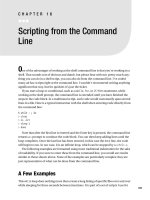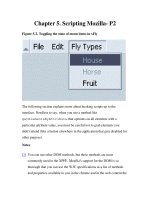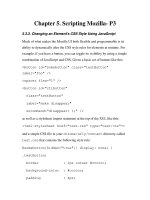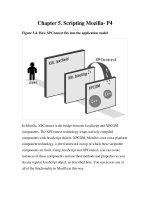Cross-Site Scripting Prevention
Bạn đang xem bản rút gọn của tài liệu. Xem và tải ngay bản đầy đủ của tài liệu tại đây (338.83 KB, 19 trang )
C
ross-site scripting (XSS) is one of the most common vulnerabilities of web applications.
In such an attack, a hacker stores untoward CSS, HTML, or JavaScript content in the
application’s database. Later, when that content is displayed by the application—say,
as part of a bulletin board posting—it alters the page or runs some code, often to steal a user’s
cookies or redirect confidential information to a third-party’s site.
XSS is a popular and often easy-to-achieve exploit because web applications largely echo
user input. Indeed, most web applications cycle repeatedly between showing information, col-
lecting input, and showing new information in response. If an attacker can submit nefarious
code as input, the application and the web browser do the rest. In general, a successful XSS
attack can be traced to careless application design.
There are primarily two types of XSS vulnerabilities: a direct action where the injected in-
put is echoed only to the injecting user, and the stored action, where any number of future users
“see” the injected content. A direct action usually attempts to gain insight about an application
or a web site to deduce a more substantial exploit. A stored action, arguably the most danger-
2
Cross-Site
Scripting
Prevention
54
Cross-Site Scripting Prevention
ous type of XSS since its effects are essentially unbounded, typically tries to steal identities for
subsequent exploits against individuals or the site at-large. (For instance, if privileged creden-
tials can be stolen, the entire site could be compromised.)
The Encoding Solution
So how do you secure your site—ultimately, the input sent to your site—against XSS? Fortu-
nately, this is very easy to do inside PHP, which offers a series of functions to remove or encode
characters that have special meaning in HTML.
The first of those functions is
htmlspecialchars()
. It takes a single parameter, presum-
ably raw user input, and encodes the characters
&
(ampersand),
<
(less than),
>
(greater than),
“
(double-quote), and optionally,
‘
(single-quote). All of those “special” characters get converted
to the equivalent HTML entities, such as
&
for ampersand, which effectively treat the char-
acter as a literal instead of part of the underlying page code.
$raw_input = ‘<a href=””><img src=”click_me.gif”></a>’;
$encoded_input = htmlspecialchars($raw_input);
echo $encoded_input;
//<a href=""><img src="click_me.gif"></
a>
As another example,
<
gets converted to
<
, useful because
<
typically opens an HTML tag.
It’s best to encode even the simplest user input, lest something like
<
or
>
inadvertently corrupt
the page structure.
Handling Attributes
While it may be obvious why the HTML tag open/close characters need to be escaped, many
people don’t realize the importance of encoding the quoting characters.
A fair amount of user input finds its way into attributes, which style the content of a tag and
even perform certain actions using JavaScript. In HTML, each attribute must be quoted using
either single or double quotes to ensure proper parsing. For example, if a user submits a URL
to point to an interesting page, that input is used to construct the
href
attribute of an
<a>
tag,
as in
<a href=””>php|architect</a>
.
Now consider a situation where the user includes a quote (of the same style as the open-
ing quote used to delimit the attribute’s value). As soon as a matching “closing” quote is found,
55Cross-Site Scripting Prevention
the browser terminates the current attribute and starts a new one. An attacker that places extra
attributes after the injected quote can specify new attributes that specify action events or alter
the display style of the affected tag.
By default, the single quote is left unencoded, as double quotes are most often used for
HTML attributes provided by user input. However, if you use single quotes for attributes, be
sure to have
htmlspecialchars()
encode them as well to prevent XSS.
This example tries to prevent XSS:
$input = htmlspecialchars(“#’ bogus_url=’’
url=’’
onmouseover=’window.status=this.attributes.bogus_url.value; return true’
onClick=’window.location=this.attributes.url.value’”);
echo “<a href=’{$input}’>User Home-Page</a>”;
Here, the intent of
echo
is to take the user-supplied input and emit a link to the user’s homep-
age, a common use of a URL. The
href
attribute of the
<a>
tag is enclosed in single quotes.
But in an attempt to perform a cross-site scripting attack, the user embeds a single quote
in the input that begins with
#
and ends with
value’
.
#
is intended to be the
href
attribute, the
single quote is supposed to terminate that attribute, and the string that follows the single quote
contains additional attributes to be injected into the tag.
bogus_url
and
url
are manufactured
attributes that are later recalled via JavaScript (hence, the
onmouseover
and
onClick
) to make it
appear as if URL is legitimate and to redirect the browser to a different location, respectively.
Manufacturing attributes is very clever: the attacker cannot use literal string values, since
those need to be enclosed in double quotes and double quotes are converted to
"
. How-
ever, because the single quote is not encoded by default, it can be used to create as many at-
tributes as are needed to supply values for the JavaScript code.
Hence, a visitor to the site where this “URL” is displayed thinks that the link transfers the
browser to
ilia.ws
(that’s what is displayed in the status bar, after all), but is actually trans-
ferred to
php.net
. This is but a small example and a harmless one, but the threat it demon-
strates is very real.
To escape single quotes, pass
ENT_QUOTES
as a second argument to
htmlspecialchars()
:
htmlspecialchars(“’”, ENT_QUOTES); // '
56
Cross-Site Scripting Prevention
Since handling of single quotes requires extra work, try to make your HTML attributes always
use double quotes that are automatically encoded.
HTML Entities & Filters
The ampersand character is often used in HTML code to indicate the start of an HTML entity,
as the previous encodings demonstrate. However, the ampersand can be used to bypass vari-
ous content filters defined by the application.
Let’s say that an application has a content filter that searches for the string
PERL
via a regu-
lar expression and rejects any use of that word. A creative user could manually encode each
letter to its respective HTML entity, thus bypassing the filter.
Here’s that exploit:
$input = ‘PERL’; // PERL in html encoded form
echo preg_replace(‘!perl!i’, ‘’, $input);
// will print unmodified value, no perl string was found
// the web browser however, will display PERL
The content filter fails and the content is persisted and because the browser displays an entity
as the individual character it represents, the banned text is displayed. The check fails because
it looks for the actual text, rather then its encoded value. By encoding the ampersand, how-
ever, the entity is disassembled and the final page displays the user-supplied entity as a literal
string.
$input = ‘PERL’; // PERL in html encoded form
$input = htmlspecialchars($inpit); // &#80;&#69;&#82;&#76;
echo preg_replace(‘!perl!i’, $input); // still does nothing
// the web browser will now display PERL
The encoding of ampersand is not always beneficial, though, and can actually corrupt input
in certain cases. For instance, if a form is displayed with the ISO-8859-1 character set and the
input characters are in KOI8-R, the browser automatically converts the foreign characters into
HTML entities to render the characters properly. Escaping those entities to change
&
to
&
destroys the special meaning of the entity. Consequently, when the input is echoed to the dis-
play, it often looks like gibberish.
57Cross-Site Scripting Prevention
// Илия (my name in Russian using KOI8-R)
// When submitted via POST it will appear to PHP as
Илия
// Encoding it via htmlspecialchars() will result in
&#1048;&#1083;&#1080;&#1103;
// which will be rendered by the browser as
Илия
// instead of displaying the desired Илия
If a character set other than the one specified by the page can be submitted as input, additional
post-processing is needed to prevent data corruption through excessive encoding. The code
would locate all textual entities that have been doubly-encoded and convert them to back valid
entities so that they can be rendered properly.
The ideal solution uses a regular expression to ensure that only the doubly-encoded char-
acters get converted to valid entities:
preg_replace(‘!&#([0-9]+);!’, ‘&#\1;’, htmlspecialchars($input));
This regular expression searches for all instances of
&#
that are followed by a string of digits
and replaces each instance with its original form, represented by &#
numeric_value
. The code
need not worry about instances of non-numeric entities, as those are not generated by the
browser and can only appear if supplied directly by the user. For example, if the string
&
appears on the page, it means that the original user input was
&
, the leading
&
was encoded
into
&
and the entire string was persisted as
&amp;
.
But this solution, which solves the character set problem, now reintroduces an older prob-
lem: because numeric entities are valid and get encoded, the string “PERL” entered as numeric
entities again bypasses the content filter.
What’s needed is better logic that processes character set entities correctly and ignores
entities that shouldn’t be decoded.
For this purpose the
preg_replace_callback()
function is handy: it executes a named
function for every match. The named function is passed a single argument, an array, where the
entirety of the matched string is the first element and every subsequent element is a captured
58
Cross-Site Scripting Prevention
sub-pattern. The return value of the function is used as a substitute for the original match.
For example, given the regular expression from the previous code example, the first ele-
ment of the array would be the encoded entity
&#1048;
and the second element would be
the value of the sub-pattern (
1048
).
In the code snippet below,
decode()
is the callback function:
$input = htmlspecialchars(‘PERL’);
function decode($matches) {
if ($matches[1] > 255) { // non-ascii
return ‘&#’.$matches[1].’;’; // convert to valid entity
}
if (($matches[1] >= 65 && $matches[1] <= 90) || // A - Z
($matches[1] >= 97 && $matches[1] <= 122) || // a - z
($matches[1] >= 48 && $matches[1] <= 57)) { // 0 - 9
return chr($matches[1]); // convert to literal form
}
return $matches[0]; // leave everything else as is
}
echo preg_replace_callback(‘!&#([0-9]+);!’, ‘decode’, $input); // PERL
decode()
is triggered by
preg_replace_callback()
and uses the sub-pattern that contains the
numeric value for comparison. If that value is greater then 255, the character is beyond the
ASCII range, such as a KOI8-R letter, and should be converted to a valid entity by changing
&
to
&
.
For values in the ASCII range, a little bit of validation is needed to ensure that certain en-
tities, such as
'
(
‘
),
<
(
<
), aren’t decoded. The only values to decode are those alpha-
numeric characters that require further processing by the content filters. If a character’s value
falls into one of the ranges
[65-90
-> (A-Z)],
[97,122
-> (a-z)], or
[48-57
-> (0-9)], the value is
converted to a literal via
chr()
, which takes a numeric value and returns the ASCII character as-
sociated with that value. All other entities that are doubly encoded, which are the result of user
inputting HTML entities manually, are left as-is and are later displayed as entities. For example,
if the user types
@
, the page displays
@
, not
@
.
Even with this cautious approach, there are number of issues that remain when working
with HTML entities. For instance, an entity does not need a trailing semicolon.
'
is a per-
fectly valid entity that the browser happily displays as a single quote. But if the semicolon is
optional, then all of the regular expressions shown previously could fail. To further complicate
matters, the numeric value of an entity can be expressed as a hexadecimal value. So,
@
59Cross-Site Scripting Prevention
also represents a single quote. (For complex character encoding schemas such as Unicode, the
hexadecimal form is all but standard.) Hexadecimal values aren’t covered by the regular expres-
sions shown above either.
To address both of these issues, a more robust regular expression is required and the de-
coding function needs a bit more logic. First, the regular expression:
preg_replace_callback(
‘!&#((?:[0-9]+)|(?:x(?:[0-9A-F]+)));?!i’, ‘decode’, $input);
The regular expression now captures entities that start with
&
followed by either a series of
decimal digits, or an
x
followed by digits and/or
A-F
characters. Some of the grouping sub-pat-
terns include the special
?:
qualifier, to prevent storage of the sub-pattern. Hence, the match
array only contains two elements as before: the character number (expressed in decimal or
hexadecimal form) and the complete version of the string. Finally, the semicolon at the end is
made optional. The “i” pattern modifier at the end makes all matches case-insensitive.
The decode function also acquires a bit of new code to handle the various possible val-
ues:
function decode($matches) {
if (!is_int($matches[1]{0})) {
$val = ‘0’.$matches[1] + 0;
} else {
$val = (int) $matches[1];
}
if ($val > 255) {
return ‘&#’.$matches[1].’;’;
}
if (($val >= 65 && $val <= 90) ||
($val >= 97 && $val <= 122) ||
($val >= 48 && $val <= 57)) {
return chr($val);
}
return $matches[0];
}
The
decode()
function determines the format of the numeric entity it is dealing with. If the first
character is a number (and therefore not
x
or
X
), the number is decimal; otherwise, the num-









